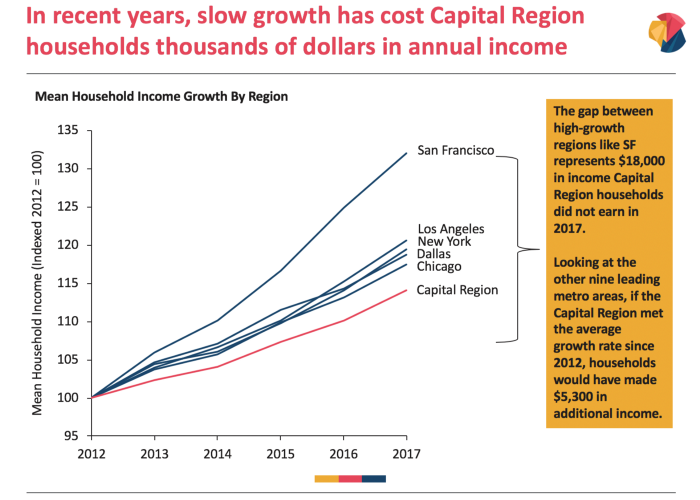The Capital Region’s economy is the 3rd largest in the United States, the 7th in the world. We are home for 10.3 million people, and 46 percent of residents above 25 years old have a bachelor’s degree or higher, one of the highest rates among major regions. We have 180+ embassies, world-leading universities and research institutions, and a burgeoning start-up scene.

The Region has so much potential. No wonder reports suggest Amazon is considering locating it’s second headquarters here.
But we should not confuse future potential with the current reality. While it may surprise some, our region is not just underperforming our potential, but significantly lagging behind other leading major regional economies. It’s costing our families, our young people, and our region opportunity, and we must change that trajectory. Smarter public policy is key, but Amazon HQ2 also represents a once-in-a-generation opportunity to reimagine our future.
The Capital Region Is A Slow Growth Economy
Compared to leading metro areas, the Capital Region is a slow growth economy. Over the past five years, the region has grown 1.2 percent on average, slower than the U.S. overall and placing us in the bottom quartile of major U.S. regional economies. San Francisco grew nearly 6 percent, while Dallas, Atlanta, and Los Angeles grew more than 3 percent. Boston and Philadelphia hovered around 2 percent. Only New York City grew at the same slow rate as the Capital Region.
We might be the 3rd largest regional economy today, but let’s compare what our slow growth at 1 percent could mean compared to the 3 percent of our peers. If the Capital Region maintains our current growth trajectory for the next 15 years, we will be an $810 billion economy. If we change our growth trajectory, hitting a robust 3 percent growth rate — like Dallas, Atlanta, and Los Angeles — we will have a $1.1 trillion economy. The difference between a high-growth and a slow growth economy is $275 billion a year.

Slow Growth’s Impacts: Less Innovation, Public Services, and Earnings
What is $275B a year in practical terms?
- It’s larger than the economies of Phoenix, Minneapolis, and San Diego today. That means we will have less businesses, start-ups, entrepreneurs, and innovators. The Region is less likely to be the home to the next Amazon.
- Assuming a conservative 10 percent tax rate, it represents nearly $30 billion a year in new tax revenues for public education, infrastructure, and housing. To put that in perspective, Washington, D.C.’s budget for the next fiscal year is $14.5 billion.
- But most importantly, slow growth robs Capital Region families of higher wages, making it more difficult to buy a home, pay for education, or enjoy all the amazing opportunities the region has to offer.
In fact, from 2012 to 2017, mean household income in the Capital Region grew only 14 percent from $101,700 a year to $116,100. Households in Boston made $97,385 in 2012, less than Capital Region households. In 2017, they now make more, $116,114. High-growth regions like San Francisco, Los Angeles, and Dallas saw 32 percent, 21 percent, and 19 percent growth, respectively.

To put that in perspective, if Capital Region households experienced the same income growth as in San Francisco, households would’ve earned $18,000 in total additional income over the past five years. If we experienced the same growth as LA and Dallas, households would’ve earned ~$5,600 in total additional income.
The Capital Region has tremendous potential. It’s an attractive place to invest, start a business, and raise a family. But without tapping that potential and changing our growth trajectory, the costs will not feel abstract — they will be real. Our children won’t stay in the region. The next innovations will happen elsewhere. Our government will have less resources to tackle the challenges we all know we must solve.
Amazon HQ2 chatter will undoubtedly continue, but as I’ve written before, Amazon HQ2 would help make the Capital Region a talent magnet, inspiring additional economic activity that will result in more growth, which in turn will create high-quality job opportunities for our residents and generate more funding for the region’s public services and infrastructure.
This post was authored by former Greater Washington Partnership CEO, Jason Miller
